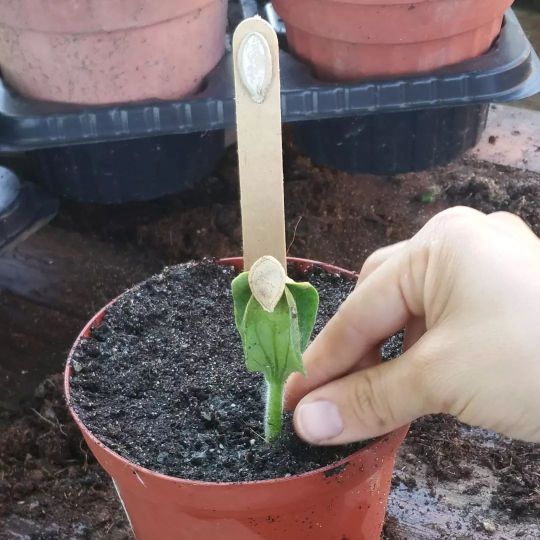#cucurbitaargyrosperma
Explore tagged Tumblr posts
Photo

Cucurbita argyrosperma, the Silverseed pumpkin, Cushaw pumpkin, or Japanese pie pumpkin is not from Japan, but from southern Mexico. Wikipedia told me it is the least cultivated pumpkin outside the Americas, so I am happy my gardener friend from Piozzo (Cuneo) gave me some silver-edged seeds in September of last year at SeMiScambi. They all germinated, and soon (in a few months) we might see the fruits. #cucurbitaargyrosperma #silverseed #silveredgedpumpkinseed #rareseeds #rarepumpkin #japanesepiepumpkin #cushaw #cushawpumpkin #cucurbitaceae #cucurbitaceaefamily #lamacchinafissa #associazioneculturalereadingretreatsinruralitaly #semiscambi #piozzo (presso La Macchina Fissa) https://www.instagram.com/p/CddduOvIvRS/?igshid=NGJjMDIxMWI=
#cucurbitaargyrosperma#silverseed#silveredgedpumpkinseed#rareseeds#rarepumpkin#japanesepiepumpkin#cushaw#cushawpumpkin#cucurbitaceae#cucurbitaceaefamily#lamacchinafissa#associazioneculturalereadingretreatsinruralitaly#semiscambi#piozzo
0 notes
Photo

The Calabazas are ready, and I'm thinking of sweet potato and squash soup! The last one spent a solid 90+ days on the vine. Still amazed that this was a volunteer🌿 pretty sure it's a variety of Cushaw Squash (Cucurbita argyrosperma). _ #calabaza #cushawsquash #Cucurbitaargyrosperma #volunteerplants #gardening #seedsaving #squashsoup #optoutside #findyourway https://www.instagram.com/p/B4UsbL-AkPJ/?igshid=7x4x0oor8ws9
#calabaza#cushawsquash#cucurbitaargyrosperma#volunteerplants#gardening#seedsaving#squashsoup#optoutside#findyourway
0 notes
Photo

Silver seeds of Pepita squash / A Pepita tök ezüstszín magjai (Cucurbita argyrosperma) Our bilingual 2019 seed catalog (english and hungarian) is downloadable from the following link / Kétnyelvű magkatalógusunk innen tölthető le: https://drive.google.com/file/d/1-WFla2rEWJdGBeprelCW6btacmHJMJjc/view?usp=sharing #pumpkin #kitchengarden #konyhakert #moestuin #jardinpotager #mik_gasztro #allotment #heirloomseeds #heirloomgardening #veggiegarden #valeyracexotics #ediblegarden #gastrophoto #gasztrofoto #instagarden #heirloom #openpollinated #seeds #squash #pepita #urbanfarm #backyardgarden #cucurbitaargyrosperma #sütőtök #gardenersofinstagram #fruitlovers #organicseeds #fruit #silver https://www.instagram.com/p/Bs5BJVxFV6-/?utm_source=ig_tumblr_share&igshid=fjcjzg92f2f6
#pumpkin#kitchengarden#konyhakert#moestuin#jardinpotager#mik_gasztro#allotment#heirloomseeds#heirloomgardening#veggiegarden#valeyracexotics#ediblegarden#gastrophoto#gasztrofoto#instagarden#heirloom#openpollinated#seeds#squash#pepita#urbanfarm#backyardgarden#cucurbitaargyrosperma#sütőtök#gardenersofinstagram#fruitlovers#organicseeds#fruit#silver
2 notes
·
View notes
Link
I don’t think I’ve shared this before. Have a read! It’s pretty amazing. Zizumbo-Villarreal does amazing work on food and animal/plant uses in Jalisco. My favorite article of his is on possible distillation in the Early Formative by the Capacha culture.
I hope to one day meet him one day. Unfortunately it doesn’t look like he is attending the SAA conference this year.

Abstract
The Food System during the Formative Period in West Mesoamerica. How was the food system structured in West Mesoamerica during the Formative Period (2400 B.C.E.–100 C.E.)?The answer is important to understanding the high cultural development accomplished by the Mesoamerican civilizations throughout the Early Classic Period (100–400 C.E.). In the same native communities of Náhuatl origins for which we previously reconstructed their putative pre–ceramic food system, we investigated the ancient dishes that could have been developed in the Formative Period; we cooked using wild, cultivated, and domesticated native plants; and we employed ceramic technologies from that time. We also recorded the ceramic objects from the Formative Period and Early Classic Period exhibited in local museums that had representations of plants, animals, and foods. We found that the Formative Period food system could have included more than 66 dishes and drinks with 29 cultivated and domesticated native plants. Compared with the putative Archaic Period food system, its nucleus continued to be composed by Zea mays, Phaseolusspp.,Cucurbitaargyrosperma,Solanum lycopersicumvar.cerasiforme,Physalis philadelphica, Capsicumannum,Hyptis suaveolens, andSpondias purpurea. These plants probably had more variants than in the pre–ceramic period, and maize gained greater relevance. The most important innovations were cooking in water and vapor,nixtamalization(soaking and cooking with water that contains lime), and possibly distillation. The elaboration of food using ceramics could have facilitated the transformation of the ingredients, raised their quality and the number of dishes, and introduced new selective pressures on the cultivated plants, all of which probably had an impact on their diversification, domestication and productivity, and on the complexity of the agro–food system.
El Sistema alimentario durante el Período Formativo en el Oeste de Mesoamérica.¿Cómo seestructuró el sistema alimentario duranteel Periodo Formativo en el Occidente deMesoamérica (2400 a.C.–100 d.C.)? La respuesta es importante para entender el altodesarrollo cultural que alcanzaron las civilizaciones Mesoamericanas en el Periodo Clásicotemprano (100 d.C.–400 d.C.). En las mismas comunidades nativas de origen Náhuatl paralas cuales previamente reconstruimos su sistema alimentario pre–cerámico putativo,investigamos los platillos antiguos que pudieron haberse desarrollado en el PeriodoFormativo usando plantas nativas silvestres, cultivadas y domesticadas, y empleandotecnología cerámica de ese periodo. Registramos además, objetos de cerámica de losperiodos Formativo y Clásico Temprano exhibidos en museos y catálogos que representanplantas, animales y alimentos. Encontramos que el sistema alimentario pudo incluir más de 66platillos y bebidas elaborados con 29 plantas nativas cultivadas y domesticadas. Su núcleosiguió conformado porZea mays,Phaseolusspp.,Cucurbita argyrosperma,Solanum lycopersicumvar.cerasiforme,Physalis philadelphica, Capsicum annum,Hyptis suaveolens,andSpondias purpurea.Estas plantas probablemente tuvieron más variantes que en elperiodo pre–cerámico, y el maíz adquirió mayor relevancia. El cocimiento en agua y vapor, elremojo y cocimiento en agua con cal (nixtamalización) y, posiblemente, la destilación, fueronlas innovaciones más importantes. La elaboración de alimentos usando cerámica pudofacilitar la transformación de los ingredientes, incrementar su calidad y el número de platillos,e introducir nuevas presiones selectivas sobre las plantas cultivadas, todo lo cualprobablemente impactó en su diversificación, domesticación y productividad, así como enla complejidad del sistema agro–alimentario.
33 notes
·
View notes
Photo

Calabazas or Winter squash 🎃 I believe the first ones are (Cucurbita mixta or Cucurbita argyrosperma), and the last two are Seminole pumpkins (C. moschata). 🌿👍Green thumb tips: Save seeds and plant them on a mound with lots of compost and once flowering - hand pollinate 🖌️🐝 ~ Cream of Calabaza coming up! 🍵 | #calabaza #wintersquash #Cucurbita #Cucurbitamixta #Cucurbitaargyrosperma #Cucurbitamoschata #handpollination #pitcomposting #donothinggardening #saveseeds #optoutside #greenthumbtips #growsomthinggreen https://www.instagram.com/p/BnREqrWHNBt/?utm_source=ig_tumblr_share&igshid=4sb3lcphzp13
#calabaza#wintersquash#cucurbita#cucurbitamixta#cucurbitaargyrosperma#cucurbitamoschata#handpollination#pitcomposting#donothinggardening#saveseeds#optoutside#greenthumbtips#growsomthinggreen
0 notes